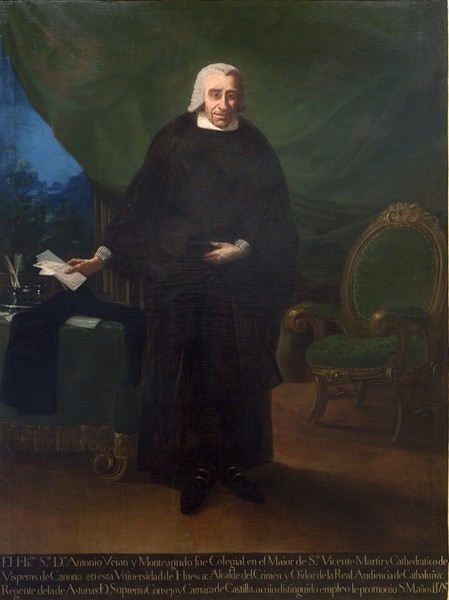- Cronología
- 1782
- Ubicación
- Museum of Huesca, Huesca, Spain
- Dimensiones
- 231 x 172,5 cm
- Técnica y soporte
- Oil on canvas
- Reconocimiento de la autoría de Goya
- Documented work
- Titular
- Government of Aragon
- Ficha: realización/revisión
- 08 Feb 2010 / 14 Sep 2022
- Inventario
- (03570)
El Himo. Sor. Dn. Antonio Veián y Monteagudo fue Colegial en el Maior de Sn. Vicente Martir y Cathedratico de / Visperas de Canono [sic] en esta Vniversidad de Huesca: Alcalde del Crimen y Oidor de la Real Audiencia de Cathaluña: / Regente de la de Asturias: Del Supremo Consejo y Camara de Castilla, a cuio distinguido empleo le promovio S. M. año de 1782. (Bottom of canvas)
Goya was commissioned to paint this portrait by the Sertoriana University for the assembly hall of this same institution. The commission came through Jaime de Salas, Professor of Canon Law at the university and its representative in Madrid, and was to commemorate Veyán being named a member of the Supreme Council and Chamber of Castile, on 14 May 1782. The painting was executed in Madrid in October of that same year. Goya charged 35 doubloons for the work. It was entrusted to the Secondary Education Institute which occupied the headquarters of the by then disbanded Sertoriana University in 1845, and in 1968 it came to form part of the collection of the Museum of Huesca when this museum took over the same site.
Antonio Veyán y Monteagudo (Tamarite de Litera, Huesca, Ca. 1710-Madrid, 1784) was a student at the collegiate school of San Vicente, graduating in Law in 1728 and in Canon Law in 1732. He held various professorships at Huesca's Sertoriana University between the years of 1733 and 1748. He was Magistrate and Judge of the Court of Barcelona, as well as Regent of the Court of Asturias and a member of the Supreme Council and chamber of Castile.
The subject, with his less than attractive features, appears here in the centre of the composition, full length, almost life-size and looking straight out at the viewer. He wears a wig, black gown and a white magistrate's collar. In his right hand he holds a piece of paper bearing the painter's signature, whilst with his left hand he is gathering up his tunic at the waist. In the background, on the left-hand side, there is a desk covered with green fabric, over the top of which are spread papers and writing materials. Behind the desk, an open window gives us a glimpse of a tree-filled landscape, painted in colours reminiscent of the rococo style. On the right-hand side is a period armchair, upholstered in the same green as the desk and the large curtain that serves as a backdrop to this domestic scene. The floor is of reddish and brown hues.
This is an official court portrait of sorts, in which the expressive possibilities are somewhat limited - a far cry from the psychological insight achieved in the artist's work from the late 1780s onwards.
This was the first full-length portrait that Goya painted.
The work was restored in the workshops of the Prado Museum between 1987 and 1989.
-
Goya (1746 – 1828)Galleria Internazionale d’Arte Moderna di Ca’PesaroVenecia1989consultant editor Antonio Fortún Paesa. From May 7th to July 4th 1989cat. 22
-
GoyaLa Lonja, Torreón Fortea y Museo Pablo GargalloZaragoza1992consultant editor Julián Gállegocat. 10
-
Realidad e imagen. Goya 1746 – 1828Museo de ZaragozaZaragoza1996consultant editor Federico Torralba Soriano. From October 3th to December 1st 1996cat. 22
-
Aragón. Escenarios de JusticiaPalacio de SástagoZaragoza2007organized by the Consejo General de la Abogacía Española and the Colegio de Abogados de Zaragoza, consultant editor Rogelio Pérez Bustamantecat. V.1
-
Goya et la modernitéPinacothèque de ParisParís2013from October 11st 2013 to March 16th 2014cat. 120
-
Un nuevo retrato de Goya en el Museo de Huesca: D. Antonio Veyán MonteagudoBoletín del Museo e Instituto Camón AznarZaragozaIbercaja1987pp. 13-20
-
Goya y Aragón. Familia, amistades y encargos artísticoscol. Col. Mariano de Pano y RuataZaragozaCaja de Ahorros de la Inmaculada de Aragón1995pp. 145-146 (il)
-
Realidad e imagen. Goya 1746 – 1828MadridGobierno de Aragón y Electa España1996pp. 88 y 89 (il.), cat. 22
-
ParísPinacoteca de París2013pp. 164-165
